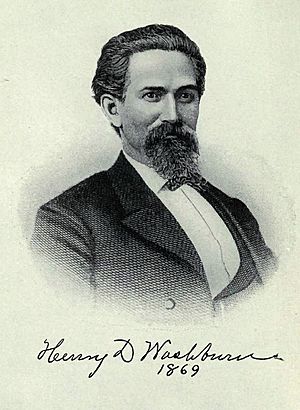Henry D. Washburn facts for kids
Quick facts for kids
Henry Dana Washburn
|
|
|---|---|
 |
|
| Born | March 28, 1832 Woodstock, Vermont |
| Died | January 26, 1871 (aged 38) Clinton, Indiana |
| Place of burial |
Riverside Cemetery, Clinton, Indiana
|
| Allegiance | United States of America Union |
| Service/ |
United States Army Union Army |
| Rank | Brevet Brigadier General |
| Battles/wars | American Civil War |
Henry Dana Washburn (born March 28, 1832 – died January 26, 1871) was an important figure in American history. He served as a U.S. Representative for the state of Indiana. During the American Civil War, he was a high-ranking officer in the Union Army. He reached the rank of colonel and later received a special honorary promotion to brevet brigadier general.
Contents
Early Life and Career
Henry Dana Washburn was born in Woodstock, Vermont. He went to local schools and learned useful skills. He worked as a tanner, which means he prepared animal hides to make leather. He also worked as a currier, finishing the leather. For several years, he taught at a school.
In 1850, Henry moved to Vermillion County, Indiana. He studied law at the New York State and National Law School. In 1853, he passed his exams and became a lawyer. He started his law practice in Newport, Indiana. He also got involved in politics. From 1854 to 1861, he served as the county auditor. This job involved managing the county's money records.
Serving in the Civil War
When the Civil War began, Henry Washburn joined the Union Army. He enlisted on August 16, 1861. He started as a lieutenant colonel in the Eighteenth Regiment, Indiana Volunteer Infantry.
Key Battles and Promotions
Washburn showed great bravery early in the war. At the Battle of Pea Ridge, he led his troops in a counterattack. They successfully took back two cannons that had been lost. Because of his excellent leadership, he was promoted to colonel on July 15, 1862. He then took command of his regiment.
After spending time in Missouri, Washburn's regiment joined General Grant's army. They were trying to capture Vicksburg, a very important city. The 18th Indiana fought in battles like Port Gibson and Champion Hill. They also took part in the long siege of Vicksburg. During the first attack in May 1863, Washburn commanded a group of soldiers called a brigade. His brigade was praised for its courageous actions.
After Vicksburg was captured, Washburn's brigade stayed with the XIII Army Corps. They were involved in operations along the Teche River. They also helped capture several forts held by the Confederate forces. In January 1864, the 18th Indiana moved to Virginia. There, they fought in several intense skirmishes.
Shenandoah Valley Campaign
In August 1864, the 18th Indiana joined the XIX Army Corps. They were part of General Sheridan's important campaign to clear the Shenandoah Valley. Washburn commanded the 4th Brigade during fierce fighting. This included the battles of Opequon, Fisher’s Hill, and Cedar Creek.
On December 12, 1864, President Abraham Lincoln nominated Washburn for an honorary promotion. He was to become a brevet brigadier general of volunteers. This promotion was confirmed by the United States Senate on February 14, 1865. In the winter of 1864-1865, his corps was stationed near Savannah. They conducted raids into areas held by the Confederates. Washburn left the army on August 26, 1865.
After the war, on May 4, 1866, President Andrew Johnson nominated Washburn for another honorary promotion. This time, it was to brevet major general. This was for his brave and outstanding service during the war. The Senate confirmed this promotion on May 18, 1866.
Life After the War
After the Civil War, Henry Washburn went back to being a lawyer. He also returned to politics. He successfully challenged the election of another politician, Daniel W. Voorhees. Washburn, a Republican, then served in the Thirty-ninth Congress. He was reelected to the Fortieth Congress. He served in Congress from February 23, 1866, to March 3, 1869. He did not run for reelection in 1868.
In 1869, he was appointed as the surveyor general of Montana. This meant he was in charge of surveying land in that territory. He held this position until his death. In 1870, he led a famous journey called the Washburn–Langford–Doane Expedition. This expedition explored the area that would later become Yellowstone National Park. Mount Washburn, a mountain inside Yellowstone, is named after him.
Henry Dana Washburn passed away on January 26, 1871, in Clinton, Indiana. He was buried in Riverside Cemetery.
See also
 In Spanish: Henry D. Washburn para niños
In Spanish: Henry D. Washburn para niños
Images for kids


